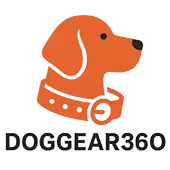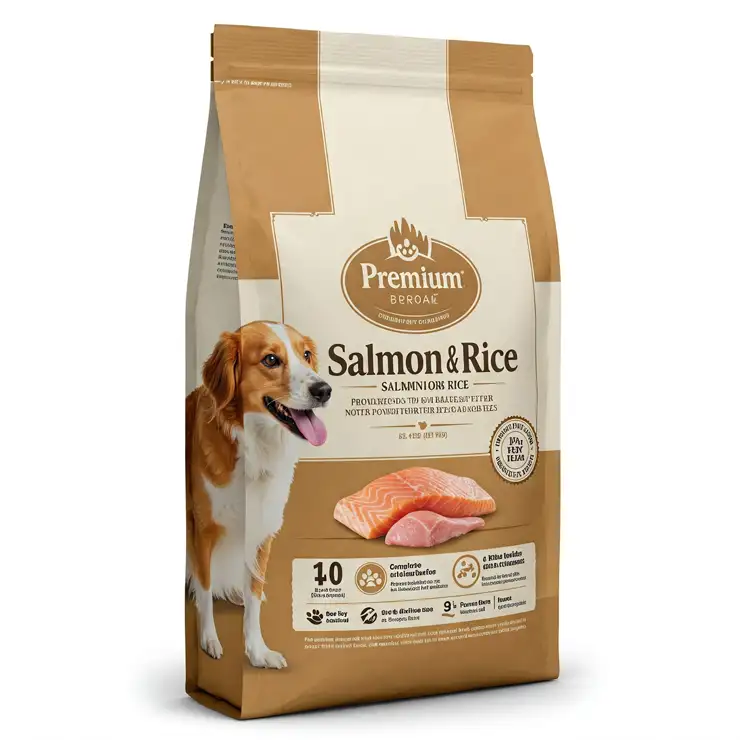✨Was this helpful? Spread the word! 🚀
Are you wondering if salmon and rice dog food is the right choice for your furry friend? As a professional canine nutritionist with over a decade of experience, I’ve researched countless dog food options, and salmon and rice dog food consistently stands out as one of the most nutritionally balanced choices available today. In this comprehensive guide, I’ll walk you through everything you need to know about salmon and rice dog food, from its unique nutritional benefits to the top products worth considering.
The pet food market can be overwhelming with endless options, but salmon and rice dog food has gained tremendous popularity in recent years – and for good reasons. This particular combination offers a perfect balance of lean protein, digestible carbohydrates, and essential fatty acids that support your dog’s overall health from nose to tail.

Why Salmon And Rice Dog Food Deserves Your Attention
Salmon and rice dog food formulations offer a powerhouse of nutrition that addresses multiple aspects of canine health. The primary ingredients – wild-caught salmon and wholesome rice – create a foundation that’s both highly digestible and nutrient-dense. Let’s break down why this combination works so well:
🐟 Premium Protein Source
Salmon is considered a superior protein source for dogs because it’s not only rich in high-quality, complete protein but also packed with omega-3 fatty acids. These essential fatty acids play a crucial role in:
- Supporting healthy skin and promoting a shiny coat
- Reducing inflammation throughout the body
- Improving cognitive function and brain health
- Supporting joint health and mobility
- Boosting immune system function
According to a study published in the Journal of Veterinary Medicine, dogs fed diets rich in omega-3 fatty acids from salmon showed significant improvements in skin conditions and reduced inflammatory responses compared to control groups.
🍚 Easily Digestible Carbohydrates
Rice serves as an excellent complementary carbohydrate source in salmon and rice dog food. Unlike some grain options that may trigger sensitivities in certain dogs, rice is:
- Gentle on the digestive system
- Less likely to cause allergic reactions
- A good source of energy
- Rich in B vitamins that support metabolism
- Naturally gluten-free
A research report from the American Veterinary Medical Association indicates that rice has one of the highest digestibility ratings among carbohydrate sources used in commercial dog foods.
🌱 Balanced Nutritional Profile
When combined, salmon & rice dog food creates a nutritional profile that’s well-suited to support:
- Healthy weight management
- Sustainable energy levels
- Robust immune function
- Optimal digestive health
- Reduced food sensitivities
Who Benefits Most from Salmon And Rice Dog Food?
While salmon and rice dog food can be an excellent choice for most dogs, certain dogs may benefit even more from this specific formula:
Dogs with Food Sensitivities or Allergies
Many dogs suffer from food allergies or sensitivities, often triggered by common proteins like chicken, beef, or dairy. Salmon and rice dog food offers an alternative protein source that’s less likely to trigger allergic responses. According to the Cornell University College of Veterinary Medicine, fish-based proteins like salmon are considered novel proteins for many dogs and can be ideal for elimination diets.
Dogs Needing Skin and Coat Support
If your dog suffers from dry, itchy skin or a dull coat, salmon & rice dog food might be the answer. The rich omega-3 content in salmon helps nourish the skin from within, reducing inflammation and promoting healthier skin cells and follicles.
Senior Dogs
As dogs age, they often benefit from foods that support brain health, joint function, and have anti-inflammatory properties. The omega-3 fatty acids in salmon and rice dog food provide excellent support for aging dogs, potentially slowing cognitive decline and supporting mobility.
Active Dogs
The balanced protein-to-carbohydrate ratio in quality salmon and rice dog food makes it an excellent choice for active dogs who need sustained energy and muscle support.
Top Salmon & Rice Dog Food Products Worth Considering
When shopping for salmon & rice dog food, not all products are created equal. Here are some of the best options currently available on Amazon that I’ve thoroughly researched and can recommend with confidence:
Blue Buffalo Life Protection Formula Natural Adult Dry Dog Food, Salmon and Brown Rice
This premium formula features real salmon as the first ingredient, complemented by wholesome brown rice and a blend of antioxidant-rich ingredients. What sets this product apart is Blue Buffalo’s LifeSource Bits – a precise blend of antioxidants, vitamins, and minerals selected by veterinarians and animal nutritionists to support immune system health.
✅ Pros:
- Real deboned salmon is the first ingredient
- Contains no chicken by-product meals
- Free from corn, wheat, soy, and artificial preservatives
- Includes Blue’s exclusive LifeSource Bits
- Balanced omega-3 and omega-6 fatty acids
❌ Cons:
- Premium price point
- Some picky eaters may need time to adjust
Purina Pro Plan Sensitive Skin & Stomach Salmon & Rice Formula
Specifically designed for dogs with sensitive digestion, this Purina Pro Plan formula combines salmon & rice with prebiotic fiber to promote digestive health and nutrient absorption. It’s fortified with live probiotics to support gut health and immune function.
✅ Pros:
- Formulated specifically for sensitive stomachs
- Contains prebiotic fiber for digestive health
- Includes live probiotics for gut microbiome support
- No artificial colors or flavors
- Reinforced with antioxidants for immune support
❌ Cons:
- Contains some corn products
- Not grain-free (though this is actually beneficial for most dogs)
Wellness CORE Digestive Health Adult Dry Dog Food, Salmon & Rice Recipe
The Wellness CORE digestive health line focuses on supporting optimal gut health with a balanced blend of probiotics and prebiotics. This salmon & rice formula is designed to be highly digestible while providing excellent nutritional support.
✅ Pros:
- Contains 4 probiotics plus prebiotics
- Made with premium salmon protein
- Includes digestive enzymes
- No meat by-products or fillers
- Made in the USA with globally sourced ingredients
❌ Cons:
- Higher price range
- Larger kibble size may not be ideal for small breeds
Royal Canin Adult Dry Dog Food Health Nutrition Sensitive Skin Care Salmon & Rice
Royal Canin takes a science-based approach to their formulations, and this salmon & rice blend is specifically designed to support skin health with precise nutrient ratios and high-quality ingredients.
✅ Pros:
- Formulated by veterinary nutritionists
- Enhanced with EPA and DHA for skin support
- Contains B vitamins to strengthen skin barrier
- Precise nutrient profile
- Highly digestible
❌ Cons:
- Contains some by-product meals
- More expensive than average brands
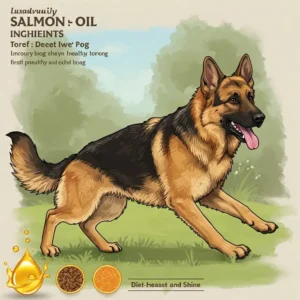
Hill’s Science Diet Adult Sensitive Stomach & Skin Salmon & Rice Recipe
Hill’s Science Diet has been trusted by veterinarians for decades, and their salmon & rice formula is specifically designed to be gentle on sensitive digestive systems while nourishing the skin and coat.
✅ Pros:
- Highly digestible ingredients
- Prebiotic fiber to support gut microbiome
- Vitamin E and omega-6 fatty acids for skin health
- No artificial colors, flavors, or preservatives
- Clinically proven antioxidant benefits
❌ Cons:
- Contains some grain products
- Limited protein sources
Comparison of Top Salmon And Rice Dog Food Products
| Product | Primary Protein | Rice Type | Special Features | Best For | Price Range |
|---|---|---|---|---|---|
| Blue Buffalo Life Protection | Deboned Salmon | Brown Rice | LifeSource Bits, Antioxidant-rich | Overall Health | $$$$ |
| Purina Pro Plan Sensitive Skin & Stomach | Salmon | Rice | Prebiotic Fiber, Live Probiotics | Sensitive Digestion | $$$ |
| Wellness CORE Digestive Health | Salmon | Brown Rice | 4 Probiotics, Digestive Enzymes | Gut Health | $$$$ |
| Royal Canin Sensitive Skin Care | Salmon | Rice | Enhanced with EPA/DHA, B Vitamins | Skin Issues | $$$$$ |
| Hill’s Science Diet Sensitive Stomach | Salmon | Brown Rice | Prebiotic Fiber, Vitamin E | Sensitive Systems | $$$$ |
💬 Just one click – help others make better buying decisions too!😊
How to Transition Your Dog to Salmon And Rice Dog Food
If you’re considering switching your dog to a salmon and rice dog food formula, it’s essential to make the transition gradually to avoid digestive upset. Here’s a recommended transition schedule:
- Days 1-2: 75% current food, 25% new salmon & rice food
- Days 3-4: 50% current food, 50% new salmon & rice food
- Days 5-6: 25% current food, 75% new salmon & rice food
- Day 7 and beyond: 100% new salmon & rice food
Some dogs may need a more extended transition period, especially those with sensitive stomachs. Watch for any signs of digestive upset, and slow down the transition if needed.
What to Expect When Switching to Salmon & Rice Dog Food
When transitioning your dog to a high-quality salmon & rice dog food, you may notice several positive changes:
- Improved Digestion: Many dog owners report firmer stools and less gas after switching to salmon & rice formulations.
- Healthier Skin and Coat: Within a few weeks, you might notice your dog’s coat becoming shinier and skin issues improving.
- Increased Energy: The balanced nutrition in quality salmon and rice dog food can lead to more consistent energy levels.
- Better Appetite: Many dogs find salmon-based foods highly palatable, which can be especially beneficial for picky eaters.
- Reduced Allergic Symptoms: If your dog has been suffering from food-related allergies, you may see a reduction in symptoms like itching, hot spots, or ear infections.
According to research published in the Journal of Animal Science, it typically takes about 8-12 weeks to see the full benefits of a dietary change, particularly when it comes to skin and coat health.
DIY Salmon & Rice Dog Food: Is It Worth It?
Some pet parents prefer to make their dog’s food at home, and salmon & rice can certainly be incorporated into homemade dog food recipes. However, creating a nutritionally balanced diet requires careful planning.
If you’re considering making your own salmon and rice dog food, here are some important factors to keep in mind:
Essential Nutritional Components
A balanced homemade salmon & rice dog food should include:
- Cooked salmon (with bones removed)
- Cooked white or brown rice
- A variety of vegetables (such as carrots, green beans, and pumpkin)
- Essential supplements (such as calcium, vitamin E, and a multivitamin formulated for dogs)
Consulting a Professional
Before starting any homemade diet, it’s crucial to consult with a veterinary nutritionist. According to the American College of Veterinary Nutrition, homemade diets without proper supplementation often lack essential nutrients, which can lead to health problems over time.
Commercial vs. Homemade
While homemade salmon and rice dog food gives you complete control over ingredients, quality commercial products are formulated by nutrition experts and undergo rigorous testing to ensure they meet all of your dog’s nutritional needs. For most pet parents, a high-quality commercial salmon & rice dog food is the more practical and nutritionally sound choice.
Understanding Dog Food Labels: What to Look for in Salmon & Rice Products
Navigating dog food labels can be challenging, but knowing what to look for can help you choose the best salmon and rice dog food for your furry friend.
Ingredients List
The ingredients list on dog food packaging is ordered by weight, with the heaviest ingredients listed first. When evaluating salmon & rice dog food, look for:
- “Salmon” or “deboned salmon” as the first ingredient (not “salmon meal” or “salmon by-product”)
- Whole rice or brown rice (preferably not rice flour or brewer’s rice)
- Limited filler ingredients
- Natural preservatives (such as mixed tocopherols)
- No artificial colors, flavors, or preservatives
Guaranteed Analysis
The guaranteed analysis section tells you the minimum or maximum levels of specific nutrients in the food. For salmon and rice dog food, pay attention to:
- Protein content (typically 22-30% for adult maintenance)
- Fat content (typically 12-18% for adult maintenance)
- Fiber content (typically 3-5% is ideal)
- Moisture content
- Omega-3 fatty acid levels (higher is better for salmon-based foods)
AAFCO Statement
Look for an AAFCO (Association of American Feed Control Officials) statement indicating that the food meets or exceeds nutritional requirements for your dog’s life stage. According to the FDA’s pet food guidelines, this is one of the most important indicators of a nutritionally complete dog food.
Common Myths About Salmon & Rice Dog Food
Let’s address some common misconceptions about salmon and rice dog food:
Myth 1: “All Dogs Should Eat Grain-Free Diets”
Contrary to popular belief, most dogs actually benefit from having some grains in their diet. According to a study by the FDA, grain-free diets have been potentially linked to heart problems in some dogs. Rice is a nutritious grain that’s easily digestible for most dogs and provides valuable nutrients.
Myth 2: “Raw Salmon is Better Than Cooked Salmon in Dog Food”
Raw salmon can contain parasites that cause salmon poisoning disease in dogs, which can be fatal. Quality salmon & rice dog foods use properly cooked salmon that eliminates these risks while preserving nutritional value.
Myth 3: “All Salmon And Rice Dog Foods Are Low in Protein”
While some lower-quality products might have insufficient protein levels, premium salmon & rice dog foods typically contain 25-30% protein, which is well within the optimal range for most adult dogs.
Myth 4: “Salmon & Rice Dog Food is Just a Fad”
Fish-based dog foods have been recommended by veterinarians for decades, particularly for dogs with food sensitivities. The salmon & rice combination is based on sound nutritional science rather than marketing trends.
Myth 5: “All Dogs Will Benefit Equally from Salmon And Rice Dog Food”
While salmon & rice dog food is an excellent choice for many dogs, individual nutritional needs can vary based on age, activity level, and health conditions. Some dogs may require specialized diets prescribed by veterinarians.

Environmental Considerations of Salmon & Rice Dog Food
As responsible pet owners, it’s worth considering the environmental impact of our pet food choices. When it comes to salmon and rice dog food, there are several factors to consider:
Sustainable Fishing Practices
The best salmon and rice dog food brands source their salmon from sustainable fisheries that follow responsible fishing practices. Look for products that mention MSC (Marine Stewardship Council) certification or other sustainability credentials.
According to the World Wildlife Fund, choosing products with sustainable seafood certification helps protect marine ecosystems while providing nutritious ingredients for pet food.
Carbon Footprint
The production of salmon & rice dog food generally has a lower carbon footprint compared to beef-based dog foods. Research from the Environmental Working Group indicates that fish-based proteins typically require fewer resources and produce fewer greenhouse gas emissions than mammal-based proteins.
Packaging Considerations
Some premium salmon and rice dog food brands are taking steps to use more environmentally friendly packaging. Look for products that use recyclable bags or containers to minimize environmental impact.
Special Considerations for Different Life Stages
Nutritional needs vary throughout a dog’s life, and salmon and rice dog food formulations can be adapted to meet these changing requirements.
Puppies
Puppies need more protein, fat, and calories to support their rapid growth and development. Look for salmon & rice puppy formulas that contain:
- Higher protein content (around 28-30%)
- Increased DHA for brain and eye development
- Higher calorie density
- Properly balanced calcium and phosphorus for bone development
Adult Dogs
Most standard salmon & rice dog food formulations are designed for adult maintenance, providing balanced nutrition for healthy adult dogs. These typically contain:
- Moderate protein levels (22-26%)
- Balanced fat content (12-16%)
- Appropriate fiber levels for digestive health
- Comprehensive vitamin and mineral profiles
Senior Dogs
As dogs age, their metabolism slows, and their nutritional needs change. Senior-specific salmon & rice formulas often include:
- Slightly lower calorie content
- Higher levels of antioxidants
- Enhanced omega-3 fatty acids for cognitive function
- Glucosamine and chondroitin for joint support
- Higher fiber content for digestive health
Athletic or Working Dogs
Dogs with high activity levels need more calories and protein to support their energy expenditure and muscle maintenance. Performance-focused salmon & rice formulas typically offer:
- Higher protein levels (28-32%)
- Increased fat content for energy (16-20%)
- Enhanced antioxidants for recovery
- Additional B vitamins for energy metabolism
How to Store Salmon And Rice Dog Food Properly
Proper storage is essential to maintain the nutritional integrity and freshness of salmon and rice dog food. Here are some best practices:
Dry Salmon & Rice Dog Food
- Store in the original bag or in an airtight container
- Keep in a cool, dry place away from direct sunlight
- Avoid humid areas that could promote mold growth
- Use within 6 weeks of opening for optimal freshness
- Check the expiration date before purchasing
Wet Salmon & Rice Dog Food
- Refrigerate unused portions immediately after opening
- Store opened cans with a silicone cover or transfer to an airtight container
- Use refrigerated portions within 3-5 days
- Never leave wet food out for more than 2 hours
- Do not freeze unless specified by the manufacturer
According to pet food experts at Tufts University Veterinary School, proper storage is crucial for preventing nutrient degradation and maintaining food safety.
When to Consult Your Veterinarian About Salmon & Rice Dog Food
While salmon & rice dog food is generally a healthy choice for most dogs, there are situations where you should consult with your veterinarian before making a switch:
Medical Conditions
If your dog has been diagnosed with a specific medical condition such as kidney disease, liver problems, or pancreatitis, they may require a specialized therapeutic diet. Always consult with your veterinarian before changing the diet of a dog with medical issues.
Weight Management Concerns
If your dog is overweight or underweight, your veterinarian can help determine the appropriate caloric intake and recommend a specific formulation of salmon and rice dog food that aligns with their weight management goals.
Persistent Digestive Issues
If your dog continues to experience digestive issues after transitioning to salmon and rice dog food, it’s important to consult with your veterinarian to rule out underlying medical conditions.
Allergic Reactions
While salmon & rice dog food is often recommended for dogs with food sensitivities, some dogs may be allergic to fish. If you notice signs of an allergic reaction (such as excessive itching, redness, or digestive upset), seek veterinary advice immediately.
Making the Most of Your Salmon And Rice Dog Food
To maximize the benefits of salmon and rice dog food, consider these practical tips:
Proper Portion Control
Even the highest quality salmonand rice dog food can contribute to weight gain if overfed. Follow the feeding guidelines on the packaging, adjusting as needed based on your dog’s activity level, age, and metabolism. Using a measuring cup rather than estimating portions can help prevent overfeeding.
Consistent Feeding Schedule
Most adult dogs thrive on a consistent feeding schedule of two meals per day. Maintaining regular feeding times helps regulate your dog’s digestive system and can prevent issues like hunger vomiting or excessive begging.
Supplemental Considerations
While quality salmon and rice dog foods are nutritionally complete, some dogs may benefit from specific supplements. Always consult with your veterinarian before adding any supplements to your dog’s diet.
Common supplements that might complement a salmon & rice diet include:
- Probiotics for digestive health
- Glucosamine and chondroitin for joint support
- Additional omega-3 supplements for severe skin conditions
- Vitamin E for enhanced antioxidant support
Regular Monitoring
Pay attention to how your dog responds to their salmon & rice diet over time. Monitor their weight, coat condition, energy levels, and stool quality, and be prepared to make adjustments if needed.
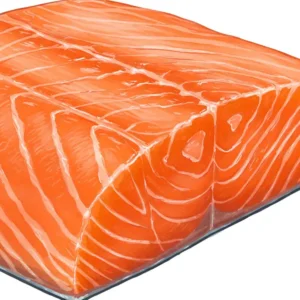
The Future of Salmon And Rice Dog Food
The pet food industry continues to evolve, and we’re seeing some interesting trends in the salmon and rice dog food category:
Sustainable Sourcing
Leading brands are placing increased emphasis on sustainably sourced salmon and environmentally responsible farming practices for rice. This trend is likely to continue as consumer awareness of environmental issues grows.
Functional Ingredients
Many newer salmon & rice formulations are incorporating functional ingredients like turmeric, green-lipped mussel extract, and specific mushroom varieties to enhance anti-inflammatory and immune-supporting properties.
Personalized Nutrition
Some companies are now offering personalized salmon & rice dog food formulations based on your dog’s specific needs, age, activity level, and health concerns. This trend toward customization is expected to expand in the coming years.
Fresh and Freeze-Dried Options
Beyond traditional kibble, we’re seeing more fresh refrigerated and freeze-dried salmon & rice options entering the market, offering alternative textures and potentially enhanced nutrient preservation.
Enhancing Your Dog’s Meals with Salmon & Rice Food Toppers
If you’re not ready to switch entirely to salmon & rice dog food, you might consider using salmon & rice toppers to enhance your dog’s current diet. These can provide many of the nutritional benefits while allowing for a more gradual transition.
Wild Alaskan Salmon Oil with Pollock Oil for Dogs & Cats
This premium fish oil supplement can be drizzled over your dog’s regular food to add omega-3 fatty acids. What makes this product stand out is its purity and concentration of EPA and DHA.
✅ Pros:
- Pure wild-caught Alaskan salmon oil
- No additives or fillers
- Convenient pump dispenser
- Supports skin, coat, joints, and immune function
- Sustainably sourced
❌ Cons:
- Fish odor (though most dogs love it)
- Requires refrigeration after opening
Honest Kitchen Meal Booster: Salmon & Rice Recipe
This dehydrated food topper combines wild-caught salmon with wholesome rice and vegetables for a nutritional boost to any meal.
✅ Pros:
- Human-grade ingredients
- Minimally processed
- Easy to serve
- Enhances palatability
- Adds nutrients without many calories
❌ Cons:
- More expensive than standard dog food
- Short shelf life once opened
The Bottom Line on Salmon & Rice Dog Food
Salmon & rice dog food represents an excellent nutritional choice for many dogs, particularly those with sensitive digestion or skin issues. The combination of high-quality protein from salmon and easily digestible carbohydrates from rice creates a foundation for optimal health that benefits dogs of all ages and activity levels.
When selecting a salmon & rice dog food, prioritize products that list real salmon as the first ingredient, use whole-grain rice rather than by-products, and avoid artificial preservatives, colors, and flavors. Pay attention to AAFCO certification and consider your dog’s specific life stage and health needs.
Remember that the best food for your dog is one that meets their individual nutritional needs and that they enjoy eating. While salmon & rice dog food has many benefits, always consult with your veterinarian about the best dietary choices for your specific pet.
🔍 Find Your Perfect Salmon & Rice Formula Today! 🐾
Ready to give your dog the nutrition they deserve? Click on any of the highlighted products above to check current pricing and availability on Amazon. Your furry friend will thank you with a wagging tail and boundless energy!
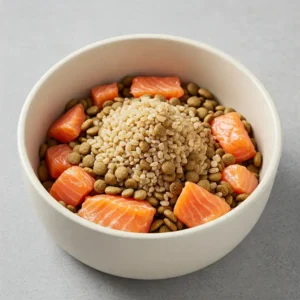
Frequently Asked Questions About Salmon And Rice Dog Food
❓ Can puppies eat salmon and rice dog food?
✅ Yes, but choose formulas specifically designed for puppies. Puppy-specific salmon & rice foods contain higher protein levels, more DHA for brain development, and properly balanced calcium-phosphorus ratios essential for growth...
❓ How much salmon and rice dog food should I feed my adult dog?
✅ Follow the feeding guidelines on the package, typically ranging from 1-4 cups daily depending on your dog's weight (20-80 pounds). Adjust based on activity level, metabolism, and body condition. Always measure portions rather than estimating...
❓ Is salmon and rice dog food good for dogs with allergies?
✅ Absolutely! Salmon is a novel protein for many dogs and rice is less likely to trigger allergic reactions compared to wheat or corn. Many veterinary dermatologists recommend salmon & rice formulas as part of elimination diets for identifying food sensitivities...
❓ How long does opened salmon & rice dog food stay fresh?
✅ Dry formulas remain fresh for 4-6 weeks when stored properly in the original bag or airtight container in a cool, dry place. Wet food should be refrigerated and used within 3-5 days. Always check for signs of rancidity like off odors or mold...
❓ Can salmon and rice dog food help with my dog's dry, itchy skin?
✅ Yes, the omega-3 fatty acids in salmon help reduce inflammation and improve skin barrier function. Most dogs show noticeable improvement in skin and coat condition after 6-8 weeks on a quality salmon & rice diet with adequate EPA and DHA levels...
Recommended for You:
- 10 Amazing Benefits of Cod Dog Food for Your Furry Friend’s Ultimate Health
- 10 Excellent Whitefish Dog Food Options For Canine Health in 2025
- 10 Best Sardine Dog Food Options for Optimal Canine Health in 2025
Disclaimer: This article contains affiliate links. If you purchase products through these links, we may earn a small commission at no additional cost to you.
✨ Found this helpful? Share it with your friends! 💬🤗
